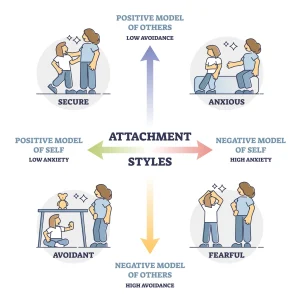Attachment theory, developed by psychologist John Bowlby, proposes that the early relationships and bonds formed between infants and their caregivers shape individuals’ attachment styles, which influence their emotional and relational patterns throughout life. There are four primary attachment styles with some information about each below.
– Secure Attachment: Individuals with secure attachment styles typically had caregivers who were responsive, consistent, and emotionally available during infancy. As a result, they feel secure in their relationships, trust others, and are comfortable with both intimacy and independence. They are able to communicate their needs effectively and form healthy, stable relationships based on mutual respect and support.
– Anxious-Preoccupied Attachment: Anxious-preoccupied individuals often experienced inconsistent or unpredictable caregiving during infancy. They may crave closeness and validation from others but harbor fears of abandonment or rejection. They may be overly sensitive to perceived signs of rejection or withdrawal from their partners, leading to clingy or needy behavior in relationships.
– Dismissive-Avoidant Attachment: Dismissive-avoidant individuals may have had caregivers who were emotionally distant, dismissive, or neglectful during infancy. As a result, they tend to downplay the importance of close relationships, prioritize independence, and avoid emotional vulnerability. They may struggle with intimacy and have difficulty expressing their emotions or forming deep connections with others.
– Fearful-Avoidant (Disorganized) Attachment: Fearful-avoidant attachment styles often stem from experiences of trauma, abuse, or inconsistent caregiving during childhood. Individuals with this attachment style may have conflicting desires for closeness and independence, leading to ambivalence and confusion in their relationships. They may fear rejection or abandonment while also feeling uncomfortable with emotional intimacy.
It’s important to note that attachment styles are not fixed or immutable; they can evolve over time in response to new relationship experiences, personal growth, and therapeutic interventions. Someone who was formerly anxiously attached might look more secure after therapy focusing on attachment related concerns. Additionally, individuals may exhibit varying attachment styles in different relationships or contexts.
At MVC, we aim to help people understand their attachment style, how it originated and how it is showing up in present day. We hope to provide a secure attachment in the client/therapist dyad to facilitate corrective emotional experiences.

